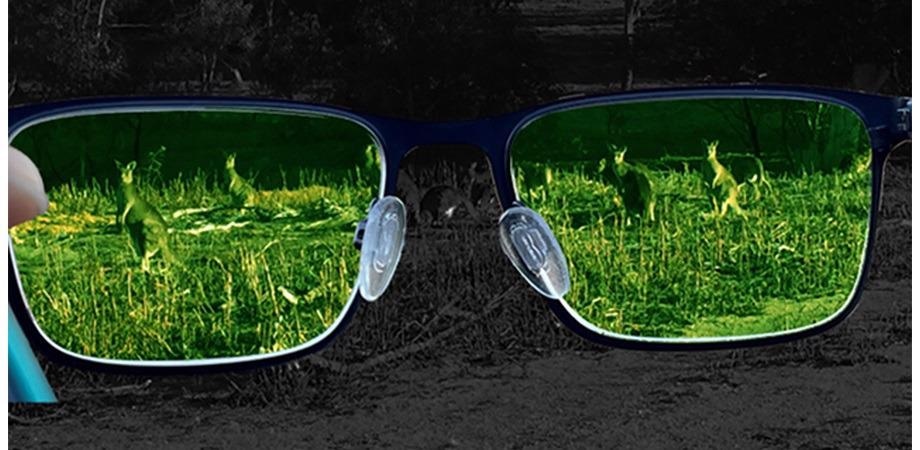Jun 16 2021
Due to a wide range of applications, such as night vision devices, lidar, remote sensing and food quality monitoring, the need for detecting infrared (IR) light, which is invisible to human eyes, is continuously growing.
 The new proof-of-concept technology is ultracompact, ultralight, and may one day enable infrared imaging on standard glasses. Image Credit: Lei Xu, Nottingham Trent University.
The new proof-of-concept technology is ultracompact, ultralight, and may one day enable infrared imaging on standard glasses. Image Credit: Lei Xu, Nottingham Trent University.
In commercially available IR cameras, infrared light is converted to electrons and the resulting picture is projected on the display. This display interferes with normal vision by blocking the transmission of visible light. Moreover, due to the low energies of the IR photons, IR detectors need low temperatures and even cryogenic cooling, thus making them heavy and bulky.
Using a nonlinear optical process to transform IR radiation into visible light provides an all-optical alternative to conventional cameras. In this example, electrical signals are not involved in the IR detecting process, and the image, which is changed to the visible, can be recorded by a phone-type camera or captured by the eye.
Nonlinear sum-frequency generation (SFG) is the optical process used in this method. In this SFG process, a pair of incident photons, one of them remaining in the IR spectrum, produce emission at higher and visible frequencies by interacting inside a nonlinear material. Yet, in the usual methods, this conversion depends on costly and bulky nonlinear crystals.
The use of ultrathin nanocrystal layers, called metasurfaces, serves as a highly attractive platform to resolve these limitations. Metasurfaces are essentially planar arrays of closely packed nanoantennas developed to exploit the numerous properties of the incident light, such as its frequency.
Dielectric and semiconductor metasurfaces, among various examples, have demonstrated significant potential to improve nonlinear optical processes at the nanoscale. Due to the stimulation of optical resonances and excellent coupling to free space, such metasurfaces can display improved frequency conversion.
Therefore, the use of nonlinear metasurfaces offers a potential approach to up-convert IR photons to visible frequencies and thus capture IR objects via coherent conversion using ultralight and ultrathin devices. Most significantly, transparent metasurfaces can conduct IR imaging in a transmission mode while transmitting visible light to enable normal vision.
Keeping this aspect in mind, scientists from The Australian National University, Nottingham Trent University, and colleagues across the world were able to demonstrate IR imaging through nonlinear metasurfaces made up of tiny semiconductor nanocrystals.
As described in the Advanced Photonics journal, the researchers created a multitenant metasurface to improve the field at all frequencies involved in the SFG process. The designed metasurface was created and transferred to a clear glass, where it formed a layer of nanocrystals on the surface of the glass.
During an experiment, the metasurfaces were illuminated by an IR image of a Siemens-star target. The target's infrared picture was combined with a second beam and, via the SFG process, up-converted to a visible wavelength at 550 nm (green light).
The perceptible green images recorded with a standard camera, correspond to various transverse positions of the target, such as the case when the target was completely removed from the IR beam path and SFG emission from the metasurface was detected.
Despite the fact that various sections of the IR signal beam are being up-converted by separate nanocrystals composing the metasurface, the images were suitably reproduced into the visible.
The recommended metasurface-based IR imaging technique opens up new possibilities that are not possible in traditional up-conversion systems, for instance, the application of counter-propagating excitation beams, incidence at various angles, and, most crucially, multicolor IR imaging by a suitably engineered metasurface.
As a result, the researchers’ findings can support the upcoming development of compact sensor devices and night vision instruments, providing an ultra-compact and ultrathin platform as well as novel functionalities, like multicolor IR imaging at room temperatures.
Journal Reference:
Camacho-Morales, R., et al. (2021) Infrared up conversion imaging in nonlinear metasurfaces. Advanced Photonics. doi.org/10.1117/1.AP.3.3.036002.